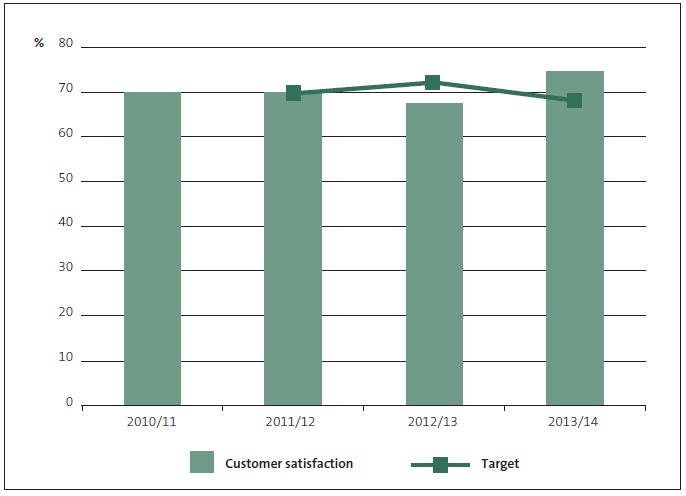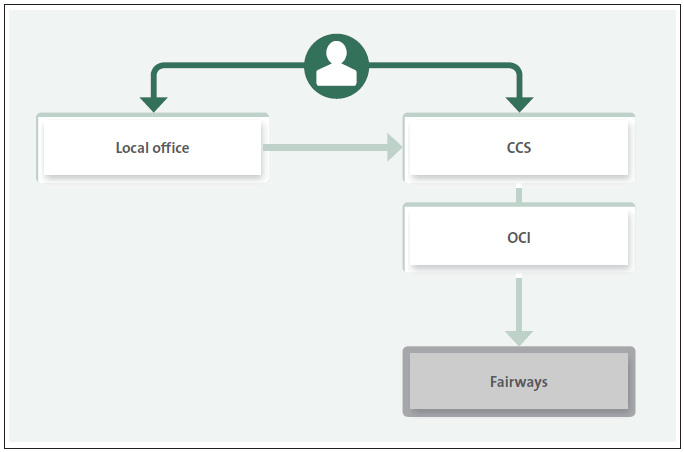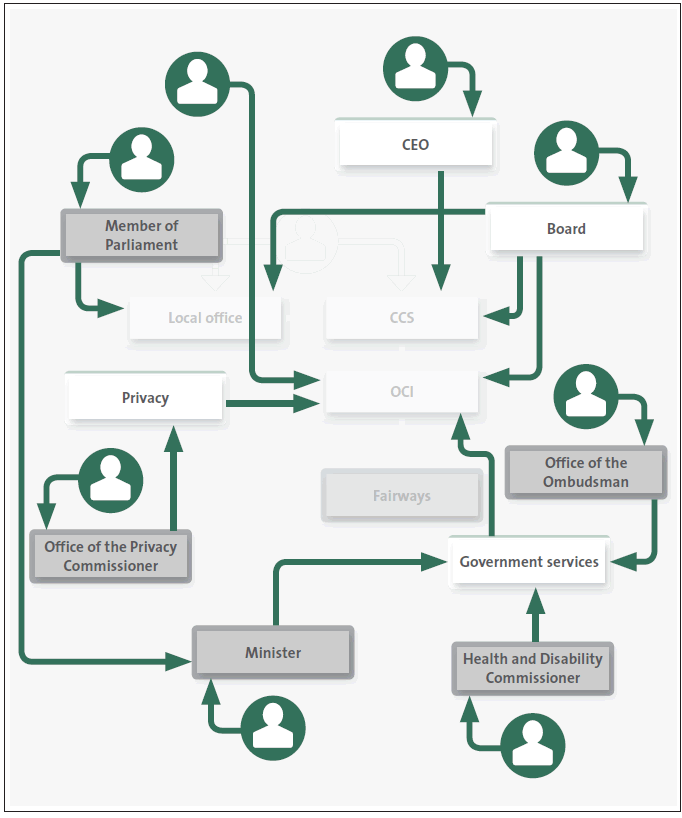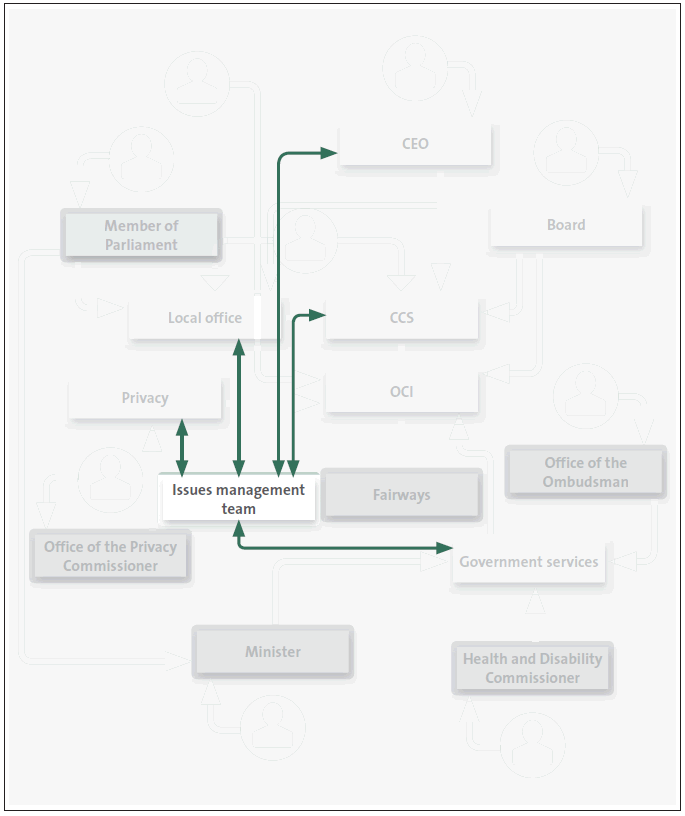Part 2: Handling complaints
This research project concluded that [best practice occurs] when the ACC approach to complaint remedies and their application achieves both the purpose and spirit of the Code for most complainants ... However, for many, not a majority, ACC performance falls short of these benchmarks ...
"Restoring Relationships" report, 2008
2.1
In this Part, we discuss:
- customer satisfaction and complaints trends;
- the reasons for complaints;
- external reviews of how ACC manages complaints; and
- ACC's complex complaints system.
Summary
2.2
ACC tries to fix problems at the lowest possible level in the organisation and as quickly as possible. This is consistent with good practice but we are uncertain about how consistently and effectively this approach is applied.
2.3
Several teams and groups are involved and better co-ordination and some streamlining is needed. The latest development in complaints management, an issues management team, is useful but adds another inconsistent process to an already inconsistent and complex system.
2.4
The main reasons for complaints have been consistent since at least 2008 – they include people feeling that they were not fully informed, not treated fairly, and not treated with dignity and respect.
2.5
ACC has known about these problems for some time and is working on them. ACC's "Shaping our Future" initiative offers an opportunity to simplify and embed lasting improvements in the complaints system.
Customer satisfaction and complaint numbers
Customer satisfaction
2.6
ACC obtains relatively detailed information about "customer" satisfaction, including satisfaction at a local office level. From 2010/11 to 2012/13, the measured levels of satisfaction declined. In 2013/14, satisfaction increased to 75%. Figure 3 shows the percentage of people who said they were satisfied with their ACC service experience, from 2010/11 to 2013/14.
Figure 3
Percentage of ACC claimants satisfied or very satisfied, 2010/11 to 2013/14

Source: Accident Compensation Corporation.
Recorded complaints
2.7
ACC records complaints about breaches of the Code. The number of complaints that ACC recorded fell from about 2200 in 2011/12 to about 1600 in 2012/13. A total of about 1400 complaints were recorded in 2013/14.
Unrecorded complaints
2.8
ACC's "service recovery" approach (see paragraph 2.25) encourages resolving matters at the lowest possible tier of the system – the local office. ACC does not categorise or record the interactions at the local office as complaints. If they were called complaints, we estimate that ACC would have received about 20,700 complaints in 2012/13. We discuss this further in paragraph 5.27.
The reasons for complaints
We were told that case managers speak “legalese” rather than plain English.
2.9
ACC has no detailed complaints data so cannot be certain about the root causes of complaints. The reasons for this are varied, and explained in the following Parts of this report.
2.10
We asked frontline staff what they thought was the main cause of people's dissatisfaction. About 55% said that it was related to both a non-entitlement issue (that is, a service issue) and a cover or entitlement issue (for example, a decision). Staff told us that people often conflated these two issues.
2.11
Through our survey, we asked people who had complained to ACC to tell us what their complaint was about. The four most common responses were:
- claim or entitlement (decision) (32%);
- staff service (32%);
- payment issues (26%); and
- policy, process, or legislation (25%).
2.12
These themes were repeated in our interviews with complainants. Some examples of the feedback we received included:
- ACC "cherry-picked" problems;
- case managers speak "legalese" rather than plain English;
- ACC wanted only short-term claimants and long-term claimants have to "fight for everything".
2.13
We also received some positive feedback about ACC staff, including that some individual staff members were "lovely" and did a very good job.
2.14
To shed more light on the reasons for complaints, we drew together findings from several sources (see Figure 4). It shows that communication problems were the main factor behind people's complaints, and this has been consistent since 2005. Some of the information is specific to categories in the Code, because the Code is at the centre of how ACC defines and manages complaints.
Figure 4
Our collated analysis of the main reasons why people complain to ACC
| Date | Source | Main findings | Distribution |
|---|---|---|---|
| 2014 | OCI monthly report for March 2014. Breach information for July 2013 to March 2014. |
Top four Code breaches in order:
|
These four Code areas accounted for 96% of all Code breaches. |
| 2012 | ACC research team report, Analyses of complaints: A mixed methods approach. The analysis was of 0800 telephone line complaints data for the period from September 2010 to January 2012. |
The analysis was not structured around Code areas, so is not directly comparable with the other data. However, the main complaint was about communication. |
Communication problems accounted for 60% of all complaints. |
| 2008 | External review report, Accident Compensation Corporation Code of Claimants' Rights: Restoring Relationships. Analysis of complaint data for the period June 2007 to October 2007. |
Top four Code breaches in order:
|
These four Code areas accounted for 96% of all Code breaches. |
| 2008 | External review report, Accident Compensation Corporation Code of Claimants' Rights: Restoring Relationships. Analysis of complaint data for the period November 2005 to June 2007. |
Top four Code breaches in order:
|
These four Code areas accounted for 94% of all Code breaches. |
Source: Office of the Auditor-General.
External reviews of how the Accident Compensation Corporation manages complaints
2.15
In 2005, ACC asked an external management consultant10 to review how effectively ACC handled complaints. The 2005 review found that ACC needed to:
We were told that ACC “cherry-picked” problems.
- communicate more with complainants;
- consider complaint events using a wide perspective, because most complaints were about matters that were not clear cut;
- reconsider its dependence on apologies as remedies because they were unlikely to resolve the complaint and restore the relationship; and
- wherever possible, move the complaint process from investigations to frontline resolution – only after this step should a formal investigation take place.
2.16
After the 2005 review, ACC adopted a service recovery approach to handling complaints, which we describe further in paragraph 2.25.
2.17
In 2008, ACC asked the same consultant to review its approach to remedies and how this compared to other organisations and good practice. The 2008 report stated that best practice would be achieved when complaint remedies achieved the purpose and spirit of the Code. The consultant found that, for some complainants, ACC did little to improve complainants' experiences and confidence in ACC and the quality of services provided.
2.18
The 2008 review found that, when remedies included an apology and a promise to improve service, local office managers rarely told complainants what changes they were making to improve the service. In many instances, the complainant's experience did not restore their relationship with ACC. Among other matters, the review recommended that:
- staff ask the complainant what outcome they sought and whether achieving this outcome would restore the relationship with the complainant;
- local office and complaints service staff be required to follow up how complaints were dealt with; and
- those investigating complaints take steps to remove perceived "aloofness" and help to restore relationships with complainants.
A complex complaints system
2.19
In theory, ACC has a staged approach to handling complaints (see Figure 5). In practice, the system allows many entry points, which are not co-ordinated well (see Figure 7). Often, staff and complainants do not follow the staged approach, which means that people might be treated inconsistently.
2.20
The service recovery approach and the Code encourage ACC to deal with complaints at the lowest possible tier – the local office. All the offices we visited had a reasonably consistent approach, involving an internal referral from staff members to team and local office managers. After this, if the complainant is still not satisfied, the complaint should be sent to CSS.
2.21
Instead of contacting the local office, some complainants go direct to CSS through the 0800 telephone number. Some complainants bypass CSS and go to OCI directly by requesting that OCI investigate their complaint.11 Some frontline staff told us that they bypass CSS and direct complainants to OCI because they find that CSS often directs complainants back to the local office as part of the service recovery approach. OCI is the highest tier in ACC's internal complaints system.
2.22
Some complainants choose to complain through other channels, such as the Ombudsman, Office of the Privacy Commissioner, local members of Parliament, or ACC's chief executive. Some complainants complain through several channels at the same time. This "scatter gun" approach makes dealing with the complaint more difficult to manage and co-ordinate.
2.23
Some complainants are deeply upset and behave in ways that the Ombudsman describes as "unreasonable complainant conduct". ACC has no consistent approach to dealing with this sort of conduct (see paragraphs 4.68-4.76).
2.24
The complexity and inconsistency of ACC's complaints system make it less effective and efficient than it should be. Both the external consultant and ACC's 2008 National Issues Management Strategy recommended a tiered complaints system with a good sorting process based on complexity and combining all complaints (Code, non-Code, and decisions). In practice, ACC only partly met this recommendation because it inconsistently applies the principles in the 2008 National Issues Management Strategy.
Core complaints system
2.25
The core complaints system is based on the service recovery approach, introduced in 2006. The service recovery approach aims to:
- identify and maximise opportunities to resolve the cause of dissatisfaction;
- resolve complaints at the lowest possible tier; and
- restore a positive relationship between ACC and the person who complained.
2.26
Figure 5 shows the three internal ACC "tiers" of the core complaints system - local office, CSS, and OCI. ACC does not categorise interactions at the local level as complaints or as part of the formal complaints process. CSS and OCI are part of ACC's formal complaints process. The fourth tier is Fairways Resolution Limited, an external company responsible for running the review process on behalf of ACC. We have not audited this fourth tier.
Figure 5
Core process for receiving and escalating complaints within ACC

Source: Office of the Auditor-General. If the person complains to CSS, the complaint could be referred back to the local office or to OCI.
Local offices
2.27
ACC has 25 local offices in larger towns and cities. Also, it has several other offices, offering mostly telephone-based services, some of which deal with specific injury types, such as short-term claims12 or specific groups of claimants (such as "risky clients" – people who ACC considers could pose a danger to themselves or staff).
Customer Support Service
2.28
CSS was created in 2005, and changed its name in 2006. CSS is based in Hamilton. It has a manager and six staff. The main aim of CSS is to work with local offices and other ACC business units to facilitate and co-ordinate resolving people's complaints. CSS deals with complaints received through the 0800 complaints telephone line and complaints correspondence sent to ACC's chief executive.
Office of the Complaints Investigator
2.29
The Wellington-based OCI was created in 1994. OCI has a manager and six staff. OCI's primary role is to investigate possible breaches of the Code and make a decision on whether a breach has arisen. It can also investigate non-Code complaints. OCI had previously been largely focused on compliance, but has recently shifted to an emphasis on restoring the ACC-claimant relationship. The OCI is ACC's highest tier for resolving complaints.
2.30
When it was created, OCI reported directly to the chief executive. It now has a lower organisational profile and is about four management levels below the chief executive.
Review
2.31
If people are not satisfied with OCI's decision they can ask for an external review. This is carried out by an independent organisation, Fairways Resolution Limited, which can consider any OCI decisions made under the Code. Figure 6 shows that fewer complaint cases went to review between July 2013 and April 2014 than in the same 10-month period in the year before. ACC told us that, for 2013/14, OCI achieved a 96% "investigation upheld" rate (that is, Fairways Resolution Limited upheld the decision made by OCI on the complaint being reviewed).
Figure 6
Reviews of complaints managed by the Office of the Complaints Investigator, 2012/13 and 2013/14
| July 2012 – April 2013 | July 2013 – April 2014 | |
|---|---|---|
| Number of reviews (including withdrawn cases) | 55 | 25 |
| Number of reviews (excluding withdrawn cases) | 49 | 18 |
Source: Accident Compensation Corporation. Note: Part-year data is used to enable comparison of the current year's information with last year's information. Cases can be withdrawn from the review process at the request of the complainant.
2.32
The total number of reviews lodged in calendar year 2013 was 7232 (including those related to complaints and decisions). About 0.6% (42) of reviews were about complaints investigated by OCI.
Other groups are involved but lack co-ordination
2.33
There are other groups and individuals involved in the wider complaints system, both internal and external to ACC. All of these groups could receive, either directly or indirectly, a complaint. Our analysis of ACC data for 2013 shows that teams outside CSS and OCI might have handled up to a further 500 complaints (see paragraph 5.10).
2.34
Figure 7 shows the many other groups in ACC that receive and deal with complaints. The arrows show a person complaining to a group or individual about ACC then who that group or individual might interact with to resolve the complaint and at which level. The green boxes are ACC groups and individuals. The grey boxes are groups and individuals external to ACC.
Figure 7
Other groups and roles involved in the complaints system

Source: Office of the Auditor-General.
ACC's privacy team
2.35
Created in 2012, after an independent review of ACC's privacy and security of information, the privacy team manages privacy policy and strategy. It acts as ACC's main liaison with the Office of the Privacy Commissioner. The privacy team handle complaints received from the Office of the Privacy Commissioner and records the complaint in its own information system.
2.36
The team advises and supports the network of local offices on privacy matters. The privacy team has eight staff. There are also another 100 staff in the client information team, working on processing privacy-related matters. The privacy team provides technical advice to OCI on any complaints they deal with that include privacy elements.
ACC's government services team
2.37
The government services team has several responsibilities. With complaints, the team's responsibilities are to act as the main liaison point and deal with complaints received from the Office of the Ombudsman and the Minister's office. These complaints are often discussed with OCI, but the government services team records its work in its own information system.
Issues management team
2.38
The issues management team (IMT) was established in 2013. Its role is to ensure oversight, co-ordination, and quicker resolution of emerging issues. ACC has not defined what an "issue" is, but describes it as a customer problem that is likely to have the potential to be high profile. Figure 8 shows how IMT sits in the context of the complaints system. The arrows indicate from which ACC groups or individuals an issue can be escalated to IMT. The arrows also show that ACC groups or individuals retain responsibility for resolving the issue. IMT's role is a support one.
Figure 8
Issues management team within the complaints system

Source: Office of the Auditor-General.
2.39
IMT provides support to help frontline staff and managers deal with problems quickly. This is consistent with the principles of service recovery. IMT also functions to identify and deal with problems that involve reputational risk to ACC. There is a process for IMT to involve the chief executive and others to reduce the usual time frames for getting issues resolved. There is weekly reporting to the executive team and a daily alert to flag emerging problems.
2.40
The scope of what IMT considers is wide and includes claimants, levy payers, and healthcare providers.
2.41
IMT considers on average 15-20 referrals a week from business units including local offices. On average, only three or four of these will require intervention by IMT. The most common matters involve decisions – disagreements about cover and entitlement.
2.42
ACC told us that it is uncommon for IMT to deal with matters that involve an active complaint. IMT's work can include dealing with claimants who conduct themselves in challenging ways.
2.43
IMT's work is recorded in a stand-alone system. This limits the ability to connect their information with other complaint-related data for analysis. Every quarter, IMT works out lessons learned from issues that are referred to it, which are then passed on to the responsible business unit.
Staff costs
2.44
Figure 9 shows staff costs of CSS and OCI from 2010/11 to 2012/13.
Figure 9
Staff costs of Customer Support Service and Office of the Complaints Investigator, 2010/11 to 2012/13
| Staff costs $000 | |||
|---|---|---|---|
| 2010/11 | 2011/12 | 2012/13 | |
| Customer Support Service | 461 | 444 | 472 |
| Office of the Complaints Investigator | 585 | 609 | 638 |
| Total | 1,001 | 1,053 | 1,110 |
Source: Accident Compensation Corporation.
2.45
The staff costs of the core complaints system (OCI and CSS) equate to about 0.25% of ACC's operating expenses in 2012/13. Based on our estimate of the cost of complaints, the overall staff costs are equal to about 0.40% of operating costs. This estimate includes the cost of complaints handled at the local office and independent reviews of complaints (see paragraphs 5.26-5.29).
We were told that some individual staff members were “lovely” and did a very good job.
2.46
The best organisations think of complaint services as adding value. There are benefits of handling complaints well that are difficult to quantify. These benefits include:
- helping to resolve problems before they get any worse – being slow to resolve complaints can often create added aggravation for the complainant and significantly more work for a public entity;
- identifying necessary improvements to services and removing causes of complaints; and
- improving satisfaction by showing that the entity is listening and taking the complainant's concerns seriously.
10: The external consultant had more than 40 years' experience in complaints and compliance activities, including significant roles at the Westpac Banking Corporation, Australian Broadcasting Corporation, Australian Banking Ombudsman, and Victorian Treasurer's Office.
11: ACC told us that its process had changed such that all complaints made directly to OCI are referred back to CSS for "proper triage and process engagement" and complaint-recording purposes. We note that ACC's process guidelines state that, if a person asks for OCI to investigate their complaint, CSS is to escalate the complaint to OCI.
12: A short-term claim is one where the severity of the injury means a person is unlikely to receive financial support from ACC for more than 70 days.

